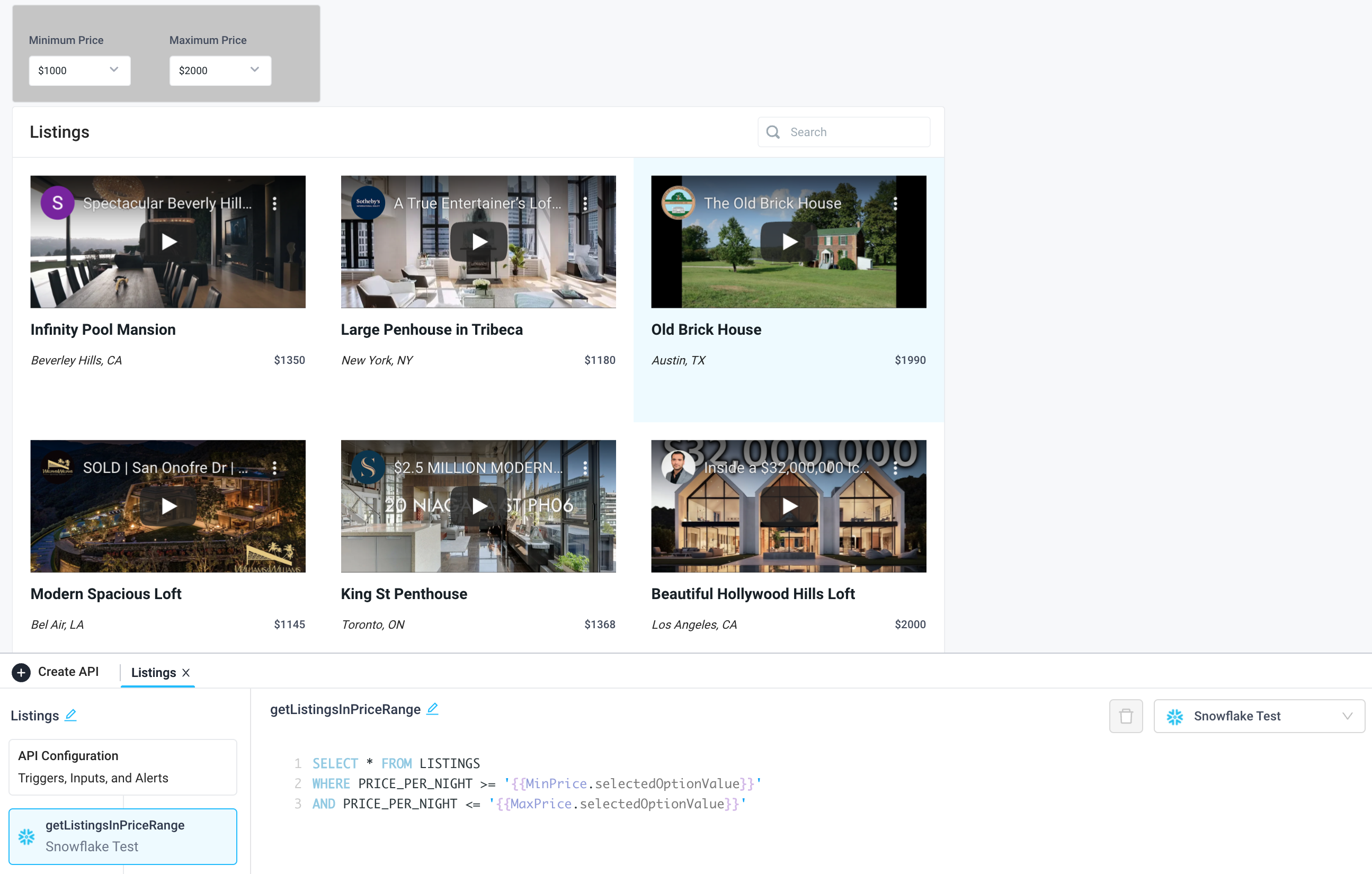
Snowflake
Overview
Snowflake is a cloud-based data platform that combines the power of a data warehouse with the flexibility of a cloud solution, enabling organizations to store, analyze, and share large volumes of data seamlessly. Using the Superblocks integration with Snowflake, teams can effortlessly build custom internal tools that leverage real-time data, streamlining workflows and enhancing operational efficiency across the organization.
Setting up Snowflake
Set up allowed IP Addresses
If you're using Superblocks Cloud, add Superblocks' IPs as allowed IPs for Snowflake. Learn how to configure this in Snowflake's guide on [Controlling network traffic with network policies](https://docs.snowflake.com/en/user-guide/network-policies
If using the Superblocks On-Premise, make sure your agent can connect to Snowflake.
Add integration
- In the web app, navigate to the Integrations page
- Click Add integration
- Search for Snowflake and select it from the list of available integrations
- Name the integration
- Fill out the integration configuration as follows:
- Password-based authentication
- Native SSO
- Key-pair authentication
- External OAuth
FieldRequired Description Account identified Snowflake account identifier. The account identifier does not include the snowflakecomputing.comsuffixUsername Login name for the user Password Password for the user Database Name of the database to use Default warehouse Name of the warehouse to use. Defaults to the user's default warehouse Default schema Name of the schema to use for the database. Defaults to public Default role Name of the role to use. Defaults to the user's default role FieldRequired Descritpion Account identified Snowflake account identifier. The account identifier does not include the snowflakecomputing.comsuffixUsername User name of Okta user Password Password of Okta user Authenticator URL The URL endpoint for your Okta account (e.g. https://<okta_account_name>.okta.com)Database Name of the database to use Default warehouse Name of the warehouse to use. Defaults to the user's default warehouse Default schema Name of the schema to use for the database. Defaults to public Default role Name of the role to use. Defaults to the user's default role For more information, see Snowflake's docs on Native SSO
FieldRequired Descritpion Account identified Snowflake account identifier. The account identifier does not include the snowflakecomputing.comsuffixUsername Login name for the user Private key The private key used for authentication. For more information, see Using key-pair authentication and key-pair rotation. Passphrase The passphrase used to decrypt the private key for the specified user. See Using key-pair authentication and key-pair rotation. Database Name of the database to use Default warehouse Name of the warehouse to use. Defaults to the user's default warehouse Default schema Name of the schema to use for the database. Defaults to public Default role Name of the role to use. Defaults to the user's default role For more information, see Snowflake's docs on Key-pair authentication
FieldRequired Description Account identifier Snowflake account identifier. The account identifier does not include the snowflakecomputing.comsuffixSubject token source Token URL The token endpoint of the authorization server, used to exchange an authorization code for an access token Client ID The ID issues to your OAuth client during registration Client secret The secret issued to your OAuth client during registration Audience Snowflake account url Scopes session:role-anyDatabase Name of the database to use Default warehouse Name of the warehouse to use. Defaults to the user's default warehouse Default schema Name of the schema to use for the database. Defaults to public Default role Name of the role to use. Defaults to the user's default role For more information:
- See Snowflake's docs on External Auth
- Check out our tutorial on Snowflake External OAuth with Okta as your IdP
- Optionally, add more configurations to set credentials for different environments
- Click Test Connection to check that Superblocks can connect
- Click Create
Snowflake connected
Now you can use Snowflake in any Application, Workflow, or Scheduled Job
Using Snowflake in APIs
Once your Snowflake integration is created, you can start using Snowflake in Superblocks APIs.
Snowflake is a SQL-based integration. Learn more in our guide on Writing SQL in Superblocks.
Example usage
Application
Visualize data from Snowflake in UI components like charts, tables, and grids.

Workflow
Enrich customer order data with shipping data from Snowflake.

Scheduled Job
Send out a daily report via email of new customer bookings.

Troubleshooting
If you run into issues, first see our guide on Troubleshooting Database Integrations.
Common errors
There are several common errors you may see when using Snowflake. The table below include error messages, why they happen, and how to address them.
Error message | Why it's happening | Resolution |
|---|---|---|
Snowflake configuration error, SQL compilation error: Object does not exist, or operation cannot be performed | When the connection is established, the user is assuming a role that does not have access to the schema specified. | Set the Default role to assume a role that has access to the selected schema. |
If you are encountering an error that's not listed, or the provided steps are insufficient to resolve the error, please contact us at support@superblocks.com